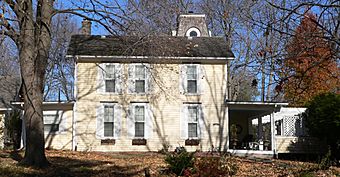William P. Hepburn House facts for kids
|
William P. Hepburn House
|
|

Hepburn house, seen from Lincoln Street
|
|
| Location | 321 W. Lincoln St. Clarinda, Iowa |
|---|---|
| Built | 1867 |
| NRHP reference No. | 73000736 |
Quick facts for kids Significant dates |
|
| Added to NRHP | June 4, 1973 |
| Designated NHL | December 8, 1976 |
The William P. Hepburn House is a special old house in Clarinda, Iowa. It is known as a National Historic Landmark. This means it is a very important place in American history. The house was once the home of William P. Hepburn (1833–1916). He was a United States Congressman. He lived here from about 1867 until he passed away.
William P. Hepburn helped create a big law called the Hepburn Act in 1906. This law gave the government power to set prices for railroads. It was a big step for the government to control private businesses. The house became a National Historic Landmark in 1976. It is a private home, so it is not usually open for people to visit.
Contents
About the Hepburn House
The Hepburn house is in a neighborhood west of downtown Clarinda. It is at the corner of West Lincoln and North 19th Streets. The house sits on a small hill. From here, William P. Hepburn could see the city's center. Today, many trees and other houses surround it.
What the House Looks Like
The house is a 2+1⁄2-story building. This means it has two full floors and a half-story, like an attic. It is made of wood and has a brick foundation. The house has an L-shape. Its roof has cross-gables, which means parts of the roof meet at an angle. The outside walls are covered with clapboard siding.
There is a flat-roof porch on the east side of the house. This is the main front of the building. Also, there is a tower with a mansard roof. This tower is located where the L-shape of the house bends.
Who Was William P. Hepburn?
This house was the main home for William P. Hepburn from 1867 until he died in 1916. It is the best-preserved house connected to his political life. He also had a house in Washington, DC.
Hepburn's Early Life and Career
William P. Hepburn trained to be a lawyer. He also fought in the American Civil War. After the war, he became involved in politics. He served as a member of the United States House of Representatives. He was a Congressman from 1880 to 1886, and again from 1892 to 1908.
Important Laws and Achievements
During his second time in Congress, Hepburn led the House Committee on Interstate and Foreign Commerce. He was very important in passing the Hepburn Act. This law greatly increased the power of the Interstate Commerce Commission. This commission could now control railroad rates and how railroads managed their money.
Hepburn also helped get approval to build the Panama Canal. This was a huge project that connected the Atlantic and Pacific Oceans. He also tried to limit the power of the Speaker of the House, Joseph G. Cannon.



